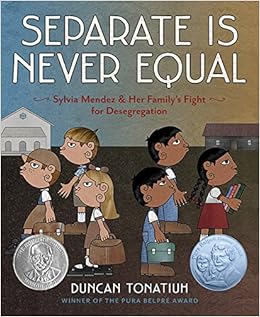Today I'll be reviewing Separate is Never Equal: Syliva Mendez and her Family's Fight for Desegregation.
 Publication Information:
Publication Information: Publisher: Abrams
Publication Date: 2014
ISBN: 9781613126332
Lexile Reading Level:
Awards/Recognition: 2015 Pura Belpre Illustrator Honor Book and a 2015 Robert F. Siebert Honor Book.
This narrative nonfiction picture book tells the story of Sylvia Mendez. About ten years before Brown v. Board of Education, Sylvia Mendez and her brothers were citizens of Mexican and Puerto Rican heritage, who spoke perfect English. Their aunt attempted to enroll them in a near by white school with her children, but the Mendez children were denied enrollment and were forced to attend Mexican school which was in a cramped, muddy barn. Sylvia's parents decided to take action and filed a large lawsuit in federal district court against the school. The Mendez family won and helped end school segregation in California.
 Separate is Never Equal begins with Sylvia's first day attending the formerly all-white school. She is teased by some of the children and when she returns home, asks her mother why she has to go there when she is not welcome and being bullied. Her mother then reminds her of what the family just went through so that she and her brothers could attend. "When she got home that afternoon, she told her mother, Felicitas, what had happened. "I don't want to go to that school anymore, the kids are mean."
Separate is Never Equal begins with Sylvia's first day attending the formerly all-white school. She is teased by some of the children and when she returns home, asks her mother why she has to go there when she is not welcome and being bullied. Her mother then reminds her of what the family just went through so that she and her brothers could attend. "When she got home that afternoon, she told her mother, Felicitas, what had happened. "I don't want to go to that school anymore, the kids are mean.""Sylvia," said her mother." ¿no sabes que por luchamos?" "Don't you know that is why we fought?" (pg. 2).
I really enjoyed this book and it would make a great read aloud for kindergarten-2nd grade or so. When we think of the Civil Rights movement, we don't always think about the segregation problems that other cultures were facing in addition to African-Americans. Sylvia Mendez's story is a great example of what the Hispanic population was also fighting at the time. The illustrations are great, and remind me a little bit of South American/temple art style (not sure where I'm going with this description and it may be just me here). The figures have very curved features, but it's complete two dimensional. None of the characters are ever seen with their face facing forward; only their side profile.
This book is a must-have for the classroom for building a diverse library. It tells the story with details that would matter to a child, meaningful, child-like language.

First of all, you're definitely not alone in your observation about the illustrations! I talked about them in another comment on a different blog and couldn't place what exactly they reminded me of (at the time I suggested the art of Egyptian hieroglyphics) but you're definitely right! They are very reminiscent of South American art. I think they specifically resemble some of the Aztec visuals, especially their ears and how the faces are all turned towards one direction of the other.
ReplyDeleteAnyway, aside from the art, I love this book choice! You're right when you say that we often only see the Civil Rights Movement as something that happened to one group of people when really it affected many minority groups. This reminded me of Rosa Parks and how, despite her notoriety for refusing to move on the bus, she wasn't the first to do this. It was actually Claudette Colvin in 1955, months before Rosa Parks did. But because Claudette was a pregnant unmarried teen at the time she wasn't given the same notoriety. These kind of forgotten people are all over our history, and it's important to educate ourselves and others about them so that they can be remembered.
This comment has been removed by the author.
ReplyDeleteI wanted to read this book, but I couldn't find it available anywhere. You are absolutely right about civil rights for other cultures. The first thing that always comes to mind is African Americans. Now, civil rights are focusing on LGBTQ peoples. The Hispanic/Latino (I am not sure what the proper term to use is.) don't get a lot of attention. When I think school segregation, I think Ruby Bridges. This is definitely something that would enhance and enlighten class discussions on civil rights.
ReplyDeleteSorry about the deleted comment! I was signed in to Blogger (I think.) I didn't even remember that I had a Blogger! I wanted to make sure you could tell my comment was from a classmate. (Plus, my last initial has changed since I had my Blogger account.)
Delete